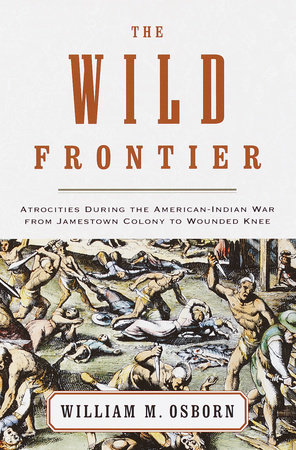The wild frontier commenced in 1607 with the arrival of the first permanent settlers and was declared ended by the Bureau of the Census in 1890. The war between the settlers and the Indians began in 1622 in Virginia and also ended in 1890 in South Dakota. The outcome of this war determined who would control the North American continent. It was played on a stage that was new to European peoples, and many of its dramatic events had not been seen before in history and would never be seen again. This was a first-time clash between 2 cultures. Robert Hughes, in Culture of Complaint, said, "Surprises crackle, like electric arcs, between the interfaces of culture." Surprises also crackle with atrocities. The war lasted 268 years, the longest in the history of our nation. The United States itself will not be 268 years old until the year 2044.
In
The West: An Illustrated History, edited by Henry Steele Commager, an article by M. A. Jones pointed out that "the realities of frontier life have regularly given way to the requirements of myth." Myths cloud history and impair its classic function—to help us solve present-day problems. This accurate analogy has been drawn by Arthur M. Schlesinger, Jr., in
The Disuniting of America:
For history is to the nation rather as memory is to the individual. As an individual deprived of memory becomes disoriented and lost, not knowing where he has been or where he is going, so a nation denied a conception of its past will be disabled in dealing with its present and its future. The Indians agreed. There is an old Sioux saying—"A people without history is like wind upon the buffalo grass."Military historian S. L. A. Marshall in
Crimsoned Prairie said in some despair, "Taken as a whole, books about the Plains wars have one salient characteristic, that of discrepancy." As Carl Waldman noted in his preface to
Who Was Who in Native American History:
A book covering such a wide range of material can be no more accurate than its sources. Much of the material comes from writers who were explorers, missionaries, traders, or army officers first, in addition to amateur historians or anthropologists. Hearsay and legend play a part in what has been passed down. Contradictions abound.Edwin T. Denig, who lived with the Indians from about 1800 to 1850 and married 2 Indian women, noted another disagreement. "We find two sets of writers, both equally wrong, one setting forth the Indians as a noble, generous, and chivalrous race above the standards of Europeans, the other representing them below the level of brute creation."
Generally speaking, most of the earlier writers were settler advocates, while many who came later were Indian advocates. Fergus M. Bordewich, who spent much of his childhood living on Indian reservations, put it this way in his book
Killing the White Man’s Indian:
Until not long ago, Americans were generally taught to view the nation's westward movement as a saga of heroic pioneering and just wars that carried European immigrants from the shores of the Atlantic to those of the Pacific. At the center of that essentially mythic vision stood the Indian, simultaneously noble and barbaric, man of nature and bloodthirsty savage, and destined for tragic extinction. The epic of the Indian wars added color and grandeur to the saga of national expansion: in their apparent savagery, Indians dramatically underscored Euro-Americans' notions of civilization, while their repeated military defeats seemed unchallengeable proof of the white man's technological and moral superiority.
More recently, revisionist scholars and educators have tended to portray that same history as one of deep, unredeemed tragedy, of which the destruction of the Indian is a central, equally mythical example, apparent proof of the barbarism of Euro-American civilization.
The word settler is meant to include colonists, soldiers, militia, government people, farmers, hunters, trappers, merchants, miners, and other Americans who came in contact with the Indians between 1607 and 1890, as well as the English colonists before the American Revolution.
This war was a "complex and intense struggle," fought over a time span of more than 26 decades. Hundreds of Indian tribes were involved. The tribes were not only fighting one another, but the Dutch, the Spanish, the English, the French, and the settlers, often at the same time.
European wars were frequently fought in part in North America. Participation in those wars by the Indians depended upon the wishes of each tribe. During the American Revolution, most tribes sided with Great Britain. One author, Carl Waldman, in
Atlas of the North American Indian, concluded that if the British had given the tribes better support, they "probably would have won the war."
No one knows for certain where the Indians originally came from. Some experts today believe that they came from some unknown part of Asia centuries ago over the Bering Land Bridge when Asia and America were connected. A growing number of other experts say the glacier there prevented use of the Bering route to our eastern seaboard until 11,500 years ago. These experts believe Asians and perhaps even Europeans hugged the ice sheets in animal skin kayaks and reached America long before the Bering people. There are also fairly recent archeological finds that hint that the Bering people may not have been in the first group to migrate to America. Anthropologist Walter Neves flatly stated, "We can no longer say that the first colonizers of the American continent came from the north of Asia." The Indians encountered in Virginia, Massachusetts, and elsewhere may or may not have been in the first group and, if not, would not have been the First Americans. The Indians had no word for themselves similar to the word Indian. According to Alvin Josephy,
Many groups of native Americans were given their historic names by white men who either contrived descriptive terms of their own for them (Creeks) or adopted expressions by which they were known to other tribes.
When they gave themselves a tribal name, however, as Clark Wissler in
Indians of the United States noted, often it was something like "we, the people."
Some have referred to the skirmishes and battles considered here as the Indian wars. Others have preferred to call them simply one war, the Four Hundred Year War (1492 to 1890) or the Four Century War. The latter is the approach taken here because the separate "wars" have been characterized by Alan Axelrod in Chronicle of the Indian Wars as "barely differentiated."
. All rights reserved. No part of this excerpt may be reproduced or reprinted without permission in writing from the publisher.








